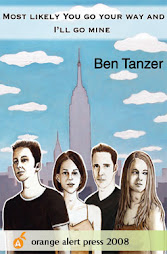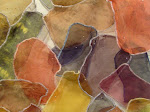
Christopher Fritton
"All human speech is finite in such a way that there is within it an infinity of meaning." from Gadamer’s Mirror
The concept of fluxus is one held in very high regard at Orange Alert. At its basic level, fluxus is the combination of art techniques into one dynamic form. At its highest level, it could be used to describe art made from text or music that allows outside influences to appear or the blending of forms and mediums. Last week we featured Rachel E. Foster, who I would consider to fall into the fluxus category. This week we bring you the work of Christopher Fritton.
I would say that New York native Christopher Fritton pushes the limits of poetry, but how do you really define poetry? In his new chapbook from sunnyoutside he writes in what could be considered a traditional manner, but on other occasions he might use glass and stamps or needles and water colors to capture his thoughts and emotions. One of my favorite pieces by Christopher is "The String Manual". It is a manual for sewing oneself inside of oneself. In addition, every year he release a hand made package of goodies (or junk) called Ferrum Wheel. "Ferrum wheel is craftonics, the raw voice of lost and found boxes, poetic parody, the ligaments between art and trash, most, it is a paper mache bust of william blake." The bottom line is I enjoy the work the Christopher Fritton because he is consistently inventing new ways to express himself in literary way. In ways that have never been fully expolred.
Recently, Christopher was kind enough to answer a few of my questions.
Orange Alert (OA): What can you tell us about your new chapbook from Sunnyoutside, My Fingernails are Fresnel Lenses?
Christopher Fritton (CF): My Fingernails Are Fresnel Lenses is a 4" x 4" book that contains a single poem in 9 stanzas on 9 pages. It is entirely hand-set, hand-letterpressed, and hand-sewn. Dave McNamara and I worked on it as a special project for Sunnyoutside Books. I've touched every page of every book, and Dave has touched every letter on every page. It has the feeling of an antique pocket-sized scientific pamphlet, treatise on epistemology, or book of bad love poems. It's all three.
OA: A fair amount of your work would fall into the category of visual poetry. Is there a distinction in your mind between visual poetry, concrete poetry, and installation art?
CF: Concrete poetry is always visual poetry, but visual poetry is not always concrete poetry. I enjoy the malleability of visual poetry - it's plasticity has really been exploited (in a good way) since the arrival of more capable software. That's not to say that a fair amount of visual poetry isn't still made by hand via collage, painting, etching, etc - but the advent of new manipulative techniques informs our handmaking as well. I prefer to handmake visual poetry pieces simply because I prefer to handmake everything, not because I dislike computer-aided work. Currently I'm working on a series of glass etchings. Back to the topic: Concrete poetry can leave me feeling flat. Once you've got it, you've got it. What still intrigues me in concrete poetry is the element of the handmade, the technique; if someone does something really intense on a typewriter or with rubber stamping, even with screenprinting, I appreciate the immense amount of repetition and registration that it took to realize the project. Installation art can be/contain either/both, but by its very nature is the least restrictive of the three. From massive earth moving projects like those of Robert Smithson to the smallest minimalist sculptures, installation has the capability to traverse a sizable aesthetic spectrum. I like to think that my future work, as it grows in scale, will integrate visual poetry and installation, possibly even concrete poetry as a way to revive the form in my own mind.
OA: The term Fluxus was created a little over 40 years ago to represent to combine of arts into one presented form. How has the idea of Fluxus changed since that time? Has technology played a role in this change?
CF: I'm not sure the idea of FLUXUS has changed. It's so categorically dynamic that it's capable of subsuming almost any new work that comes along. It's not that the idea of FLUXUS is meaninglessly broad, but it may be easier to talk about what works aren't FLUXUS, rather than what works are; a painting probably isn't FLUXUS, but painting it is, etc. Technology has affected FLUXUS work just a much as it's affected many other genres of art - by providing myriad ways to expand our notions of chance and change, replication and deconstruction, connectivity and temporality, many of which are at the very heart of FLUXUS. The internet itself, in all its bedlamic glory, may be the greatest collaborative FLUXUS work in the history of the world.
OA: Your Ferrum Wheel projects were all incredible. Will there be anything released in 2008 as part of Ferrum Wheel?
CF: First, thanks. Ferrum Wheel is something near and dear to me, a project I started with my close friend Ric Royer in 2000. And for those who don't know, Ferrum Wheel is an assembling (made in an edition of 50) - a collection of 50 one of a kind works from 10-12 different artists collected in 50 different vessels. Each one contains one work by each artist along with countless bits of found material, poetry, art, etc. If you want to check out pics of some of the back issues, hit up ferrumwheel.blogspot.com. In 2008, I'll be releasing Ferrum Wheel 7, and I'm currently working on Ferrum Wheel 6.5 - a special mail-only version made in an edition of 25.
OA: In your various bio's you reference the Performance Thanatology Research Society. Does this society research the death of performance? What is your role as the head of The Institute for the Advancement of Higher Histrionics?
CF: The Performance Thanatology Research Society doesn't research the death of performance, rather the performance of death. The performance we're all performing right now. The absolute insanity of it all. It was founded by Ric Royer, who now lives and carries on his liveness studies in the city of Baltimore. At around the same time Ric's work was culminating in the PTRS, I was seeing my own performance work come together in a series of histrionic, hysterical gestures. The Institute for the Advancement of Higher Histrionics was a call to use these gestures to break through, discover something new about living. It and the PTRS go hand in hand carrying on the tradition started by Bern Porter (who created the Institute for Advanced Thinking) - finding new ways to consider the crisis of being human and doing human things.
OA: What's next for Christopher Fritton?
CF: I just quit my job as a boat captain, so hopefully something that generates a little money. Starting a small press that does short runs as gifts to close friends, turning my garage into a studio to do larger scale work, working on new books. All of that sounds terribly lucrative, doesn't it?
Bonus questions:
OA: Coffee? If yes, what is your favorite type of coffee and where is your favorite coffee spot?
CF: Never, ever real coffee. Only decaf. I'm too high strung as it is, a single cup of coffee makes me vibrate. Favorite is a decaf caramel macchiato here at Spot Coffee in Buffalo.
OA: Do you listen to while creating? Do you ever incorporate music into your work? Who are some of your favorites currently?
CF: I listen to music constantly; it's one of the most important things in my life. Sometimes I think it's more important than writing and art. I often incorporate lines from songs into my poems, then rework them and rework them. Lately I've been listening to the new Breeders album, Herman Dune, lots of old punk rock as always, Blood on the Wall, The Blow, Panda Bear, too much to name.
+by+Nick+Volkert).jpg)





















No comments:
Post a Comment